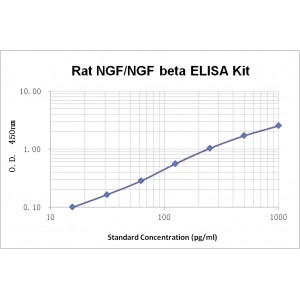More info
Assay Range | 15.6-1,000 pg/mL |
Sensitivity | 1.0 pg/mL |
Size | 96T |
Storage | Store at 2 - 8ºC. Keep reconstituted standard and detection Ab at -20 ºC |
Assay Principle | Sandwich ELISA |
Sample Volume | 100 µL final volume, dilution factor varies on samples |
Detection Method | Chromogenic |
Kit Components
1. Recombinant Rat NGF standard: 2 vials
2. One 96-well plate coated with Rat NGF Ab
3. Sample diluent buffer: 12 mL - 1
4. Detection antibody: 130 µL, dilution 1:100
5. Streptavidin-HRP: 130 µL, dilution 1:100
6. Antibody diluent buffer: 12 mL x1
7. Streptavidin-HRP diluent buffer: 12 mL x1
8. TMB developing agent: 10 mL x1
9. Stop solution: 10 mL x1
10. Washing solution (20x): 25 mL x1
Background
NGF (nerve growth factor) is a well characterized neurotropic protein that plays an important role in the proliferation, maintenance and survival of neurons in the peripheral and central nervous systems. NGF has also been shown to have biological effects on nonneuronal tissues. NGF was originally isolated from mouse submandibular gland as a 7S complex composed of three non-covalently linked subunits, α, β, and γ. Both α and γ subunits of NGF are members of the kallikrein family, while the β subunit, called βNGF, BNGF or 2.5S NGF, exhibits all the biological activities ascribed to NGF. Rat NGF and human NGF share approximately 90% amino acid (aa) sequence identity and exhibit species cross-reactivity.
NGF mediates a series of biological processes for neuronal survival by binding and activating p75 and TrkA. It is reported that NGF prevents neuronal degeneration in animal models and promote peripheral nerve regeneration in rats. NGF has been implicated in a number of neurodegenerative and/or psychiatric disorders such as Alzheimer’s disease, multiple sclerosis, schizophrenia, autism, and Rett syndrome.


